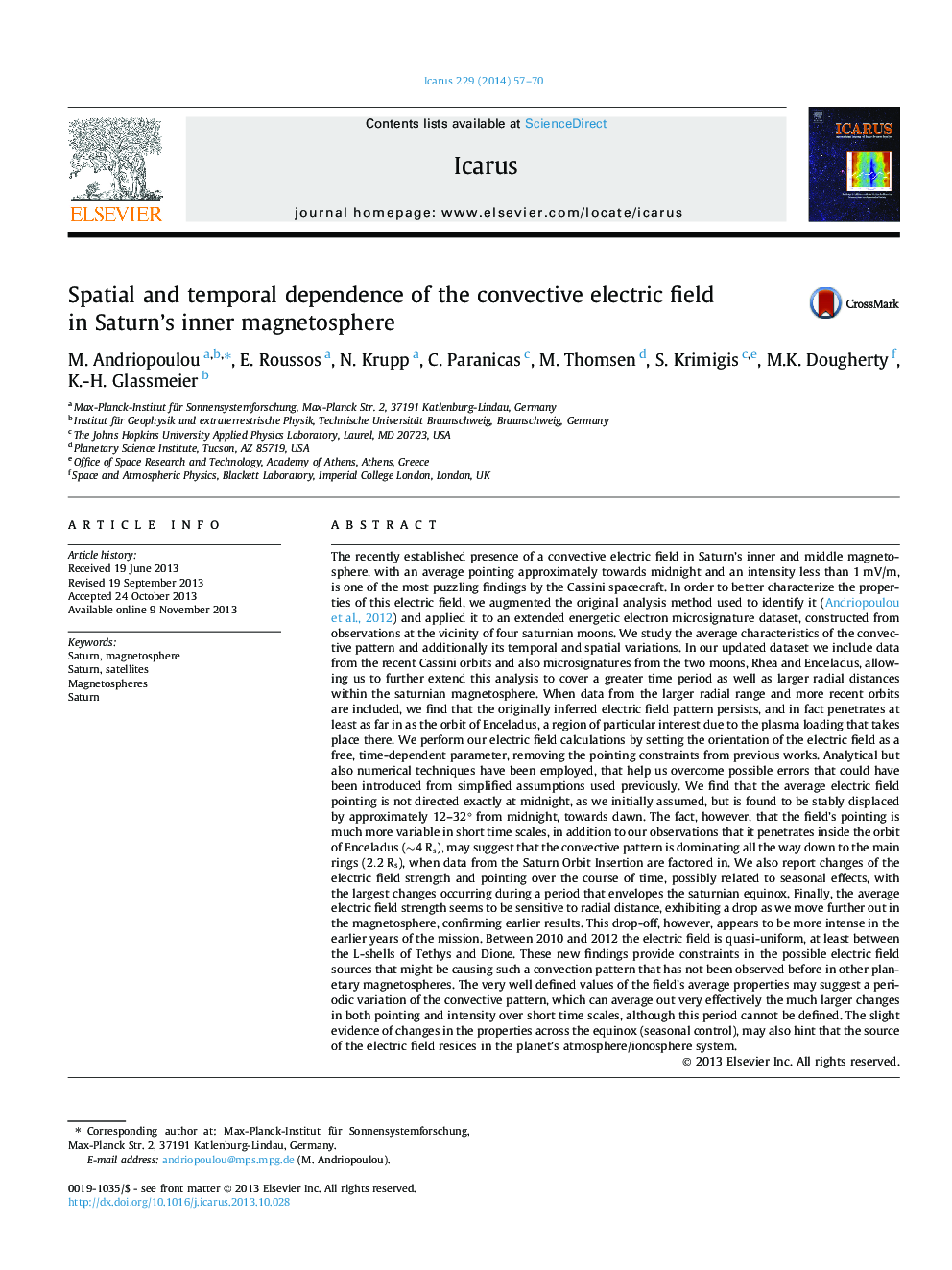| کد مقاله | کد نشریه | سال انتشار | مقاله انگلیسی | نسخه تمام متن |
|---|---|---|---|---|
| 8138782 | 1523561 | 2014 | 14 صفحه PDF | دانلود رایگان |
عنوان انگلیسی مقاله ISI
Spatial and temporal dependence of the convective electric field in Saturn's inner magnetosphere
دانلود مقاله + سفارش ترجمه
دانلود مقاله ISI انگلیسی
رایگان برای ایرانیان
کلمات کلیدی
موضوعات مرتبط
مهندسی و علوم پایه
علوم زمین و سیارات
علوم فضا و نجوم
پیش نمایش صفحه اول مقاله

چکیده انگلیسی
The recently established presence of a convective electric field in Saturn's inner and middle magnetosphere, with an average pointing approximately towards midnight and an intensity less than 1 mV/m, is one of the most puzzling findings by the Cassini spacecraft. In order to better characterize the properties of this electric field, we augmented the original analysis method used to identify it (Andriopoulou et al., 2012) and applied it to an extended energetic electron microsignature dataset, constructed from observations at the vicinity of four saturnian moons. We study the average characteristics of the convective pattern and additionally its temporal and spatial variations. In our updated dataset we include data from the recent Cassini orbits and also microsignatures from the two moons, Rhea and Enceladus, allowing us to further extend this analysis to cover a greater time period as well as larger radial distances within the saturnian magnetosphere. When data from the larger radial range and more recent orbits are included, we find that the originally inferred electric field pattern persists, and in fact penetrates at least as far in as the orbit of Enceladus, a region of particular interest due to the plasma loading that takes place there. We perform our electric field calculations by setting the orientation of the electric field as a free, time-dependent parameter, removing the pointing constraints from previous works. Analytical but also numerical techniques have been employed, that help us overcome possible errors that could have been introduced from simplified assumptions used previously. We find that the average electric field pointing is not directed exactly at midnight, as we initially assumed, but is found to be stably displaced by approximately 12-32° from midnight, towards dawn. The fact, however, that the field's pointing is much more variable in short time scales, in addition to our observations that it penetrates inside the orbit of Enceladus (â¼4 Rs), may suggest that the convective pattern is dominating all the way down to the main rings (2.2Rs), when data from the Saturn Orbit Insertion are factored in. We also report changes of the electric field strength and pointing over the course of time, possibly related to seasonal effects, with the largest changes occurring during a period that envelopes the saturnian equinox. Finally, the average electric field strength seems to be sensitive to radial distance, exhibiting a drop as we move further out in the magnetosphere, confirming earlier results. This drop-off, however, appears to be more intense in the earlier years of the mission. Between 2010 and 2012 the electric field is quasi-uniform, at least between the L-shells of Tethys and Dione. These new findings provide constraints in the possible electric field sources that might be causing such a convection pattern that has not been observed before in other planetary magnetospheres. The very well defined values of the field's average properties may suggest a periodic variation of the convective pattern, which can average out very effectively the much larger changes in both pointing and intensity over short time scales, although this period cannot be defined. The slight evidence of changes in the properties across the equinox (seasonal control), may also hint that the source of the electric field resides in the planet's atmosphere/ionosphere system.
ناشر
Database: Elsevier - ScienceDirect (ساینس دایرکت)
Journal: Icarus - Volume 229, February 2014, Pages 57-70
Journal: Icarus - Volume 229, February 2014, Pages 57-70
نویسندگان
M. Andriopoulou, E. Roussos, N. Krupp, C. Paranicas, M. Thomsen, S. Krimigis, M.K. Dougherty, K.-H. Glassmeier,